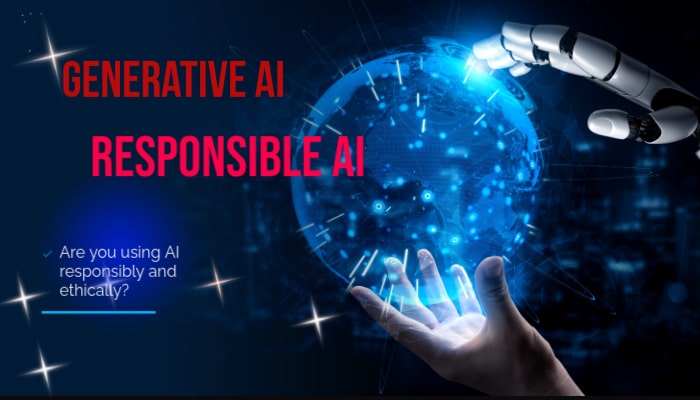Interactions with AI chatbots give you the experience of almost a real-life conversation with your friend. The latest game-changing update of the most popular AI-powered chatbot (ChatGPT) raised a storm in the tech world. But, have you heard the terms ‘responsible AI and ‘generative AI’? It is worth understanding the differences between these categories of AI.
Responsible AI allows you to use Artificial Intelligence in a way, which is fair, transparent, and sustainable. However, the emergence of generative AI has raised new interest in the technology’s potential. So, let us talk about the topic, generative AI vs responsible AI.
Key takeaways
Generative AI and responsible AI, both terms are prominent in the tech world. But, remember that they are not antagonistic concepts. Generative AI represents particular functionalities of some AI systems to produce graphics, texts, or other outputs. On the contrary, responsible AI refers to a human-driven comprehensive approach, which involves different guidelines for AI systems morally.
Remember generative AI is not a mere technology, which is to be made responsible. Rather, it is an innovative tool to make other AI-based systems highly responsible.
Generative AI vs Responsible AI- Definition
GenAI is a deep-learning model, which produces high-quality images, text, and other types of content. Using Generative AI, you can solve different problems creatively. The applications of GenAI are growing every year. For instance, IBM once used the technology to create codes. But, generative AI tools often cause ethical issues, such as misuse and bias.
These problems led to the development of responsible AI, a special approach to reducing ethical concerns. The main principles of responsible AI are-
- Privacy
- Reliability
- Transparency
- Accountability
- Fairness
So, you need to focus on these principles to use generative AI without harming society.
But, it is challenging to balance generative and responsible AI. You should ensure the responsible development of generative AI. Simultaneously, you need to embrace creativity and innovation to harness more benefits.
Click here to learn more about the benefits and limitations of GenAI.
How to Use Generative AI Responsibly
There are several ways to use generative AI responsibly and ethically
- Bias and fairness- Your generative AI models must not discriminate against a particular individual or group. They have to identify and mitigate the risk of harmful biases in algorithms.
- Transparency- Your stakeholders and target users must be aware of the capabilities and purpose of using generative AI systems.
- Data security- Protect sensitive data to train and deploy generative AI models.
- Accountability- Set clear roles for a generative AI system development and deployment. It is essential to monitor and audit the system’s performance.
Examples of how generative AI is used responsibly in various sectors
Healthcare– Generative AI analyzes biomarkers, images, and other medical data to detect symptoms. It simplifies drug discovery by simulating clinical trials and designing molecules.
Social benefits – Generative AI in the educational world helps you develop customized learning content and promote collaborative learning.
Environment sustainability– Use Gen AI to implement sustainable energy practices and generate climate data.
What Problems Can Generative AI Solve?
Different industries use generative AI to solve real-world problems.
- Financial companies struggle to manage fraudulent transactions and often experience monetary losses. GenAI detects a large amount of data in real time and finds unusual patterns, indicating fraudulent activities.
- Language barriers affect smooth communication with international customers. GenAI-driven translation tools help with seamless communication worldwide.
- Generative AI is used to design novel materials, such as high-performance alloys and biodegradable plastics.
Responsible AI Applications in the Real World
Check for a few examples of how responsible AI solves different issues.
Traffic Control– Responsible AI ensures better traffic flow by reducing congestion. AI algorithms analyze traffic data, such as vehicle running patterns and real-time traffic conditions. Based on this data, they suggest the best routes.
Customized Education– Responsible AI plays a vital role in personalizing the learning process. It adapts to students’ unique preferences and needs. AI-powered portals collect data on students’ interests and performance to tailor the learning process.
Cybersecurity- In the cybersecurity world, responsible AI detects and prevents cyber threats. Advanced AI algorithms analyze vast data, such as user behavior and network traffic.
Social robotics – Social robots are powered by responsible AI to interact with humans in different contexts, including customer service and healthcare.
Generative AI-Responsible AI Intersections
GenAI focuses mainly on the AI’s creation aspect. But, responsible AI is about its consequences. Thus, they intersect with each other and help you create innovative content responsibly.
Still, the intersection causes different challenges, such as
- Generative models should not amplify bias.
- Protect data to prevent the risk of misuse of generative models.
Generative AI Vs Responsible AI – Can You Use Both?
Artificial intelligence is, no doubt, evolving rapidly, and it will gain more importance in the coming years. So, it is worth exploring the topic, generative AI vs responsible AI. Modern generative AI models, such as GPT-4o and GPT-4o Mini have the potential to accelerate scientific discovery and empower creativity. However, to use them safely and ethically, tech experts should implement responsible AI. This AI concept values human control and transparency.
So, generative skills and ethical behaviors must complement each other to make artificial intelligence trustworthy.
Read more articles
The Most Innovative AI Devices You Can Never Overlook


Trackbacks/Pingbacks